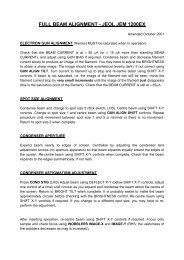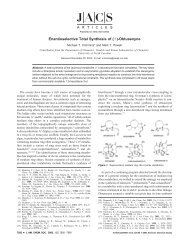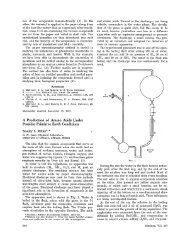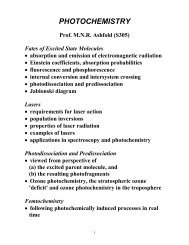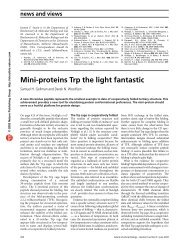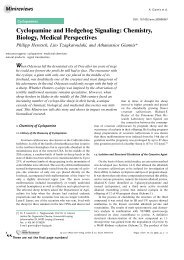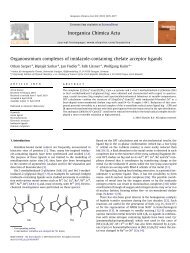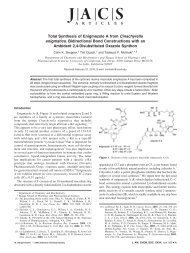Reduced Sensitivity RDX (RS-RDX) Part I: Literature Review and ...
Reduced Sensitivity RDX (RS-RDX) Part I: Literature Review and ...
Reduced Sensitivity RDX (RS-RDX) Part I: Literature Review and ...
You also want an ePaper? Increase the reach of your titles
YUMPU automatically turns print PDFs into web optimized ePapers that Google loves.
DSTO-TR-1447<br />
This paper also contained introductory details on a study using microtomography <strong>and</strong><br />
atomic force microscopy to quantitatively analyse defects in both the explosive<br />
formulation <strong>and</strong> at the explosive crystal surface. Early indications are that a<br />
relationship may exist between the crystal heterogeneity <strong>and</strong> the shock sensitiveness in<br />
PBXN-109.<br />
SNPE confirmed [5] that the process they use for producing I-<strong>RDX</strong> is a recrystallisation<br />
technique <strong>and</strong> preliminary results were presented indicating that the process seems to<br />
also be effective for HMX.<br />
2.2 DSTO Publications<br />
Previous work carried out at DSTO provided examples that the Grade A 4 <strong>RDX</strong><br />
produced in Australia by ADI Ltd has properties consistent with it being a <strong>RS</strong>-<strong>RDX</strong>.<br />
Both for PBXW-115 [2] <strong>and</strong> PBXN-109 [7] formulations, the PBXs manufactured with<br />
Grade A <strong>RDX</strong> had significantly lower shock sensitivities <strong>and</strong> increased critical<br />
diameters. No differences in the small-scale sensitiveness testing results of either the<br />
<strong>RDX</strong>s or the PBXN-109 were detected (comparative testing was not performed on<br />
PBXW-115 formulations).<br />
Additional tests [7] to examine a batch of ‘improved’ <strong>RDX</strong> supplied by Dyno Nobel<br />
showed that whilst the material imparted improved processing properties on the PBX<br />
formulation, due to the improved morphology of the recrystallised <strong>RDX</strong> compared<br />
with conventional <strong>RDX</strong>, it was not a <strong>RS</strong>-<strong>RDX</strong>. Dyno Nobel [8] also confirmed this<br />
finding. The same DSTO study [7] reported that the replacement of some of the Grade<br />
A <strong>RDX</strong> in the Australian PBXN-109 formulation with HMX did not significantly<br />
modify the reduced shock sensitivity of the PBX.<br />
Studies [9, 10] into <strong>RDX</strong>/polyethylene wax compositions contain data that provides a<br />
possible insight into the effect of <strong>RS</strong>-<strong>RDX</strong> on the shock sensitivity of pressed PBXs. The<br />
shock sensitivity of the pressed compositions increases as the density increases,<br />
however for Grade A <strong>RDX</strong> there is a distinct change in the slope of the curve at higher<br />
densities which is not apparent for Grade B 5 <strong>RDX</strong> (which has been shown to not be a<br />
<strong>RS</strong>-<strong>RDX</strong> (section 3.2.1)). This could indicate that at the pressing loads required to<br />
obtain the higher densities the <strong>RDX</strong> crystals are damaged, negating the shock<br />
sensitivity benefits of using a <strong>RS</strong>- <strong>RDX</strong>. At lower densities the <strong>RS</strong>-<strong>RDX</strong> is thought to be<br />
undamaged <strong>and</strong> the full benefit is realised through reduced shock sensitivity.<br />
Comparison with equivalent formulations using Grade B <strong>RDX</strong> shows that at lower<br />
densities the formulation containing Grade A <strong>RDX</strong> is less sensitive than the Grade B<br />
formulation. At higher densities the shock sensitivities are essentially identical.<br />
4 Grade A <strong>RDX</strong> is type I, recrystallised [6].<br />
5 Grade B <strong>RDX</strong> is type I, boiled <strong>and</strong> milled [6].<br />
3



